Artists G - K
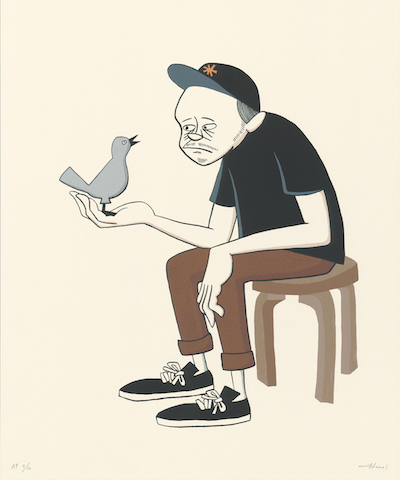
Yusuke Hanai
Down But Not Out
Silkscreen print on paper, 24 x 18 inches, 2020
The work of Yusuke Hanai (b. 1978) ranges from website design to collaborations with clothing brands like Beams and Vans to illustrations for surfing magazines. Considered a counterculture artist, Hanai has long been attracted to the beatnik and hippie culture of San Francisco, where he lived and studied art for several years. His drawings typically depict ordinary, often slightly alienated people doing their best to cope, encouraging each other, and finding their way. The figure in Down But Not Out, which has been reproduced as a painting, print, and limited-edition figurine, embodies the spirit of resilience visible in much of Hanai’s work.
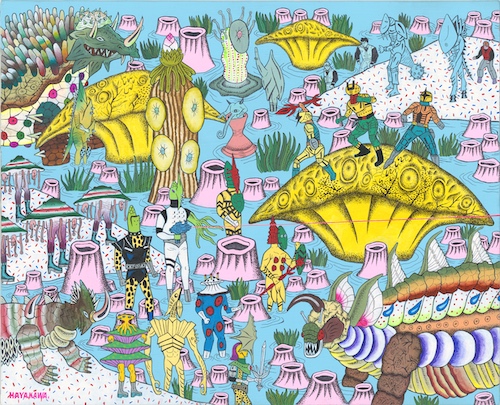
Motohiro Hayakawa
X Planet Battles
Acrylic and pen on canvas, 21 x 25 1/2 inches, 2021
Born in Yamaguchi prefecture, Motohiro Hayakawa (b. 1974) studied at Yamaguchi College of Arts and went on to work in illustration and comics. His illustrations are heavily influenced by the science-fiction adventures and cartoons of his childhood in the early 1980s as well as by American comic books and punk rock. In his highly imaginative paintings, Hayakawa employs a mixture of different textures, media, and techniques to create a world inhabited by giant plants with eyes, ancient warriors, vintage sci-fi heroes, aliens, robots, and bizarre monsters. In many of his works, these characters engage in comic-style battle scenes set in psychedelic, dreamlike landscapes.
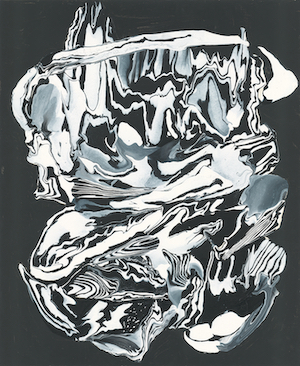
Yutaka Hirai
Black & White
Acrylic and medium on canvas, 28 1/2 x 24 inches, 2021
Based in Kamakura, Yutaka Hirai (b. 1976) is a self-taught artist who works largely in acrylic. Much of his art is figurative and at times verges on the surreal, with curious juxtapositions of motifs and settings in a rich color palette. Through his paintings, he often aims to convey personal struggles and emotional challenges. In this work, however, he has forgone color and figures for a monotone abstraction that is more expressive than representational, marbling together the opposing tones so that they harmonize in a vibrant, almost musical composition.
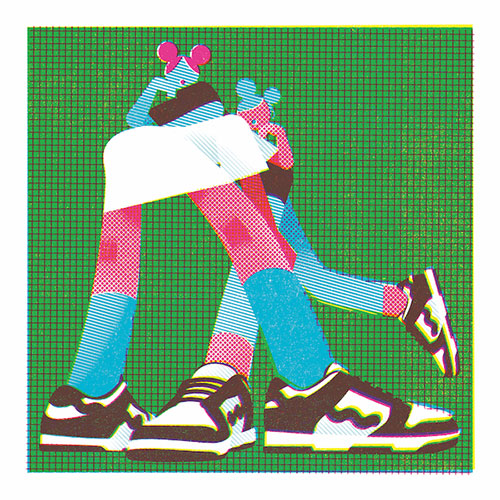
Hikaru Ichijo
Twins
Screen print on paper, 28 x 27 inches, 2021
Hikaru Ichijo (b. 1989) received her master’s degree in visual communication from Tokyo University of the Arts. In 2018, she began working as an illustrator. Her illustrations are featured in books, advertisements, and package design. Using techniques rooted in printing technology—typically Ben-Day dots—to explore color expression, she builds bold images of female figures with a fresh, contemporary pop aesthetic. She chooses not to draw their faces, freeing the characters from judgment based on shifting beauty standards. Instead, her women are strong and athletic and are often depicted from below, so they appear to tower over the viewer.
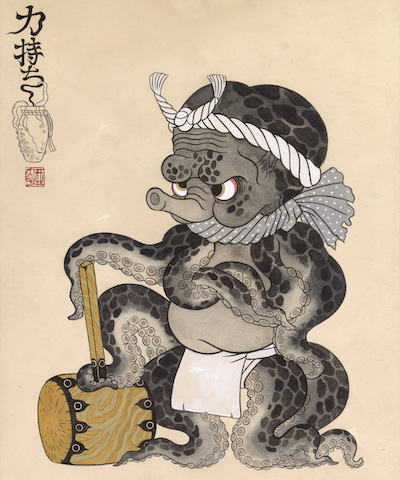
Ayako Ishiguro
Powerful
Digital print on canvas (Original: Pencil, sumi ink, pigment on washi paper, 2021), 31 x 23 1/2 inches, 2021
Ayako Ishiguro (b. 1973) is a self-taught artist and illustrator from Chiba prefecture. Her paintings and book illustrations typically feature monsters, shape-shifting animals, and other yōkai, or “mysterious apparitions” from traditional Japanese folklore and her own imagination. She is particularly well known for her illustrations of bakeneko, or monster cats. In 2016, she published a book of her yōkai images, which are at once fearsome, cute, and comical. In this work, entitled Chikarazuyoi, meaning “Powerful,” a stern-faced octopus mimics a mighty samurai warrior, wearing a hachimaki around his head and a loincloth around his waist and holding an ōtsuchi, or large wooden mallet.
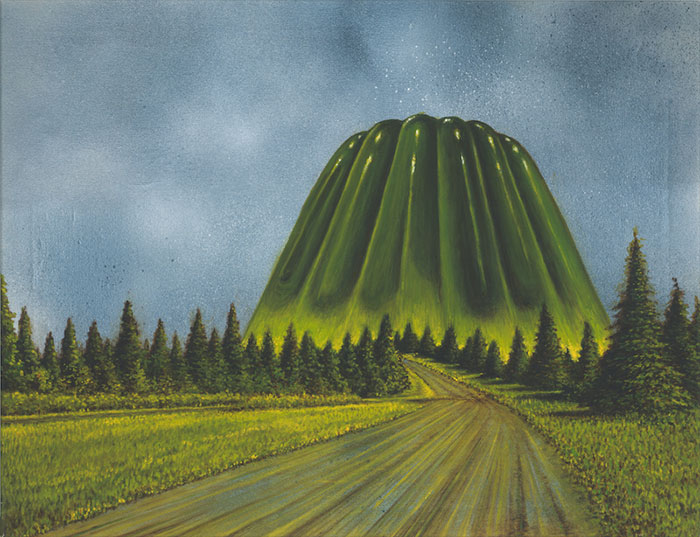
Keiji Ito
Five Tones
Giclée print on canvas, 19 1/2 x 25 1/2 inches, 2020
Keiji Ito (b. 1958) is a Tokyo-based illustrator, graphic designer, and director of Unidentified Flying Graphics (UFG). Much of his work investigates the idea that things that seem ordinary at first glance may often conceal madness and psychedelia—such as the Jello mountain in this surreal landscape, which, along with the title Five Tones, is a nod to Steven Spielberg’s 1977 science-fiction film Close Encounters of the Third Kind. To Ito, portals to other worlds lie hidden in our everyday spaces, and they can open suddenly and create a sense of incongruity; he tries to capture these moments for eternity in his paintings. Ito has had numerous solo exhibits, taken part in domestic and international shows, and produced several publications, including his latest work, FUTURE DAYS.
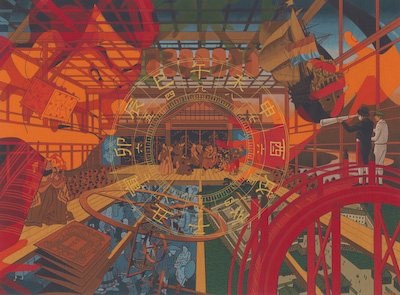
Toru Kageyama
Sharaku
Acrylic and gouache on plywood, 24 x 18 inches, 2013
Toru Kageyama (b. 1958) is an artist and illustrator originally from Aomori prefecture and is best known for his numerous book cover designs. His works show a variety of influences, including realism, the manga/anime style, and European and Chinese landscapes. In this painting, named after the mysterious artist Sharaku, who designed a series of kabuki actor prints in the late nineteenth century, the influence of Japan’s ukiyo-e woodblock print tradition is apparent. The central image is the interior of a kabuki theater, with the actors on stage in the distance and a large character from one of Sharaku’s prints on the left.
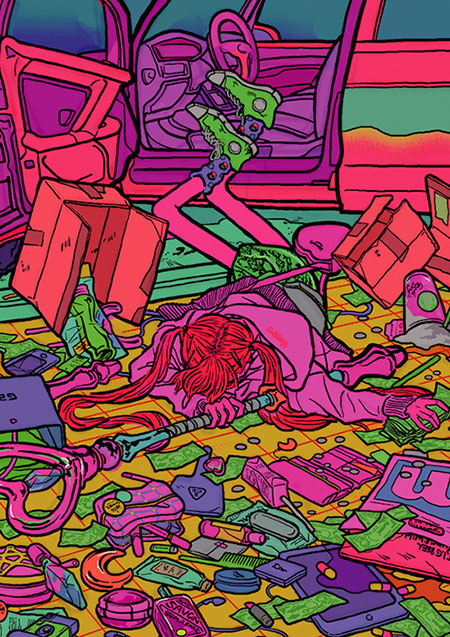
Jenny Kaori
Life is Good
Digital print on canvas, 47 x 33 inches, 2021
Self-taught artist Jenny Kaori (b. 1987) works in animation, character design, and apparel, typically depicting the young people who inhabit Japan’s sub- and mainstream cultures. Using vivid colors—and a predominantly pink color palette—she creates strong, mischievous female figures who transcend gender boundaries and challenge stereotypes of femininity and girlishness. Here, a girl appears to have fallen out of a car and is surrounded by the contents of several boxes that have spilled out all over the ground. In one hand, she holds a scepter with a heart finial; in the other, she clutches cash. The image suggests a young person overwhelmed by consumerism.
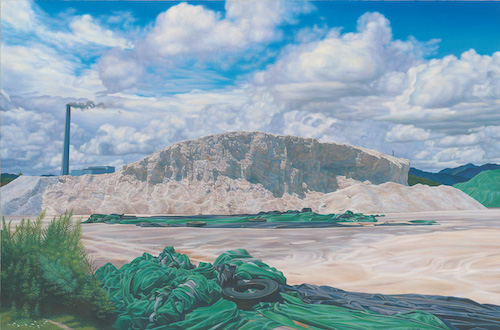
Yoko Kawamoto
Untitled
Oil on canvas, 21 x 32 inches, 2011
From Oita prefecture, Yoko Kawamoto (b. 1967) is a self-taught artist working primarily in oil on canvas in a photorealistic style. She focuses on ordinary daily scenes and underrepresented vistas that are not typically noticed or painted—museums, junkyards, sunlit suburban streets, and urban traffic. By portraying these mundane scenes with careful attention to detail, form, and lighting, she elevates each into something fascinating and important. Here, a view of a mountain of sand (mined from the sea), with cloth and tires strewn around the foreground, becomes a mysterious and intriguing landscape worthy of our attention.
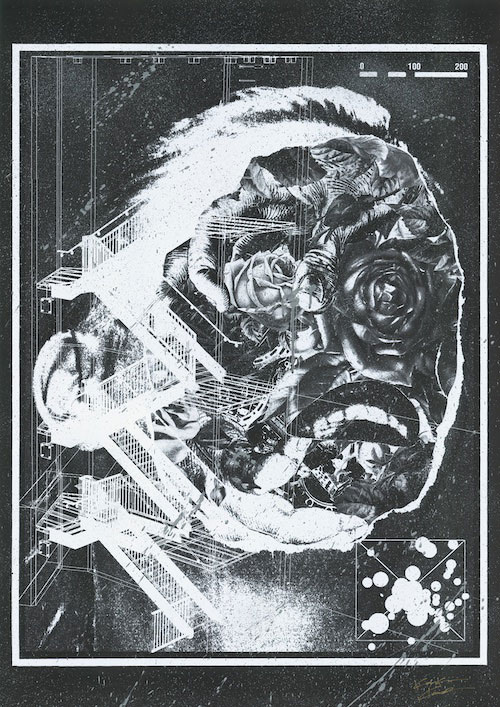
Kosuke Kawamura
Untitled
Inkjet print and acrylic spray paint on tarpaulin, 40 1/2 x 29 inches, 2020
Kosuke Kawamura (b. 1979) was born in Hiroshima prefecture. After graduating from high school, he moved to Tokyo and trained himself to be a graphic designer. He now works as a designer, art director, and collage artist, influenced in part by American artist Winston Smith. He began using a paper shredder in his work, and it soon became an important element of his collaging, allowing him to create fine patterns and designs (some of which he has used in collaborations with fashion designers). He works in both analog and digital realms for his collaged designs, often bringing together live paintings and digital imagery to create pop and avant-garde art.
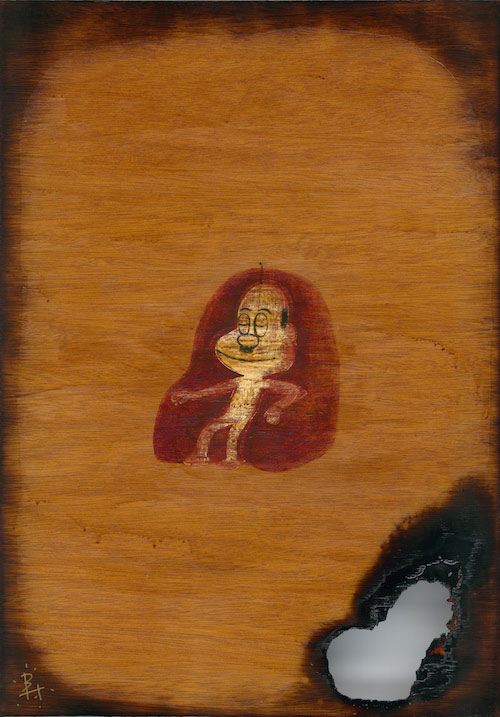
Shiriagari Kotobuki
A Short Break
Acrylic varnish on wood panel, partially scorched and coated with epoxy, 29 x 21 inches, 2021
Shiriagari Kotobuki (b. 1958) is a manga artist from Shizuoka. After graduating from Tama Art University in Tokyo, he began working in advertising, a career he continued until 1994. In 1985, he started creating manga, and ten years later, he launched a manga strip called Ereki na Haru (Electric Spring). Since 1998, Kotobuki has contributed his darkly humorous serialized manga strips to popular magazines, including Beam and AX, and several newspapers. He aims to create work that is loose, and somewhat lacking, but is still dear to his readers and often filled with humor. He teaches at Kobe Design University in the Department of Manga Media.
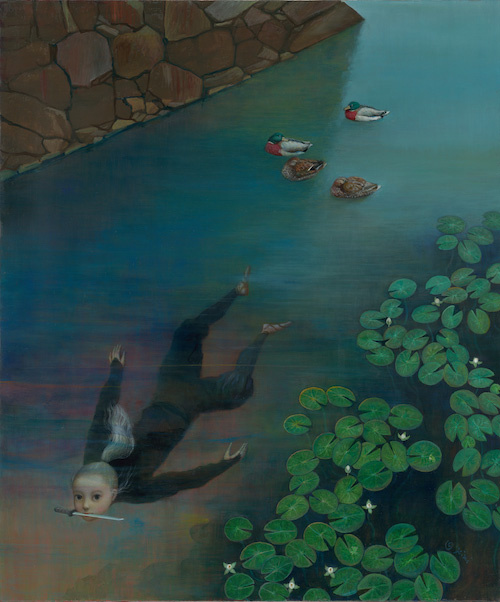
Kimi Kuruhara
Shinobi
Oil on canvas, 33 x 28 1/2 inches, 2021
Kimi Kuruhara (b. 1963) draws inspiration from sources as diverse as the natural world, medieval Christian art, and manga and anime from the 1960s and 1970s. Based in Nagano, where she also paints and crafts dolls, Kuruhara describes her work as having no specific direction. Rather, many of her images are born from ideas that pop into her head suddenly, like a story that she is sharing with a friend. Her rich imagination can be seen in this whimsical painting of a shinobi (another name for a ninja) swimming at night in a castle moat with a knife in his mouth. He moves so stealthily that he does not wake the sleeping ducks or cause a single ripple on the water’s surface.
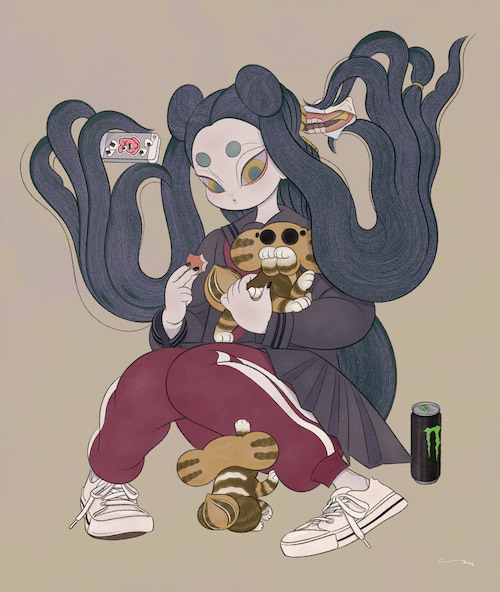
Sasaku Kusuriyubi
Lunch
Digital print on canvas, 28 x 23 1/2 inches, 2020
Sasaku Kusuriyubi is a painter based in Wakayama prefecture. The inspiration for her curious characters comes from her childhood in the countryside, where she observed that the insects, fish, and animals around her seemed to inhabit a world of life and death with no awareness of each other as individuals. Their unconscious activities became a symbol of freedom and equality for her and affirmed her own unique existence. In her art, she expresses this freedom through characterization, creating figures reminiscent of yōkai, the “mysterious apparitions” and monsters of Japanese lore. Here, a girl with magical, prehensile hair enjoys lunch in the company of her comical pets.
Main Exhibition Page

